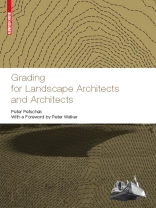‚The contour line is the only precise and accurate means for representing the free and natural formation of terrain in the plan; so learn to use this instrument!‘ Professor Hans Loidl, Landscape Architect and Teacher
The two design elements of landscape architecture are plants and terrain. While the subject of vegetation is well documented by numerous publications, there is a lack of technical literature in the field of grading.
This volume fills that gap: History, forms of terrain, basic principles, digital modeling, slope reinforcement systems, construction site implementation, and practical examples – all are treated in detail by the author. Short problems, systematically organized and arranged in increasing order of difficulty, enable the reader to apply what he or she has learned. The exercises are suitable for self-study. Together with the large amount of practical information provided by the book, they also enable architects to become familiar with grading as an important design element of landscape architecture.
Inhaltsverzeichnis
Foreword by Peter Walker.- Introduction.- History of grading.- Forms of terrain.- Basics of grading.- Digital grading.- Slope reinforcement systems.- Construction site implementation.- Practical examples.- Exercices ongrading.- Solutions.- Glossary.- Illustrations and tables.- Bibliography/sources.
Über den Autor
Peter Petschek is a landscape architect and a professor at the HSR Hochschule für Technik Rapperswil (Rapperswil University of Applied Sciences). He teaches the courses in execution, grading, CAD, DHM, and 3D landscape visualization in the Bachelor’s and Master’s Programs of the Department of Landscape Architecture. He also directs the Fachstelle für Garten- und Landschaftsbau (Research Center for Materials and Construction) of the Institut für Landschaft und Freiraum (ILF, Institute for Landscape and Open Space). The ILF is active in applied research in all areas of landscape architecture.












